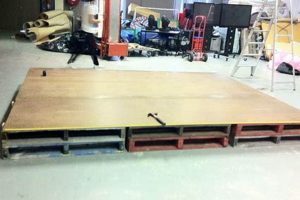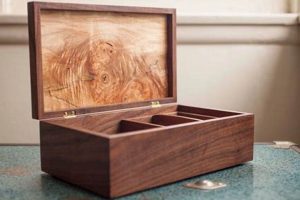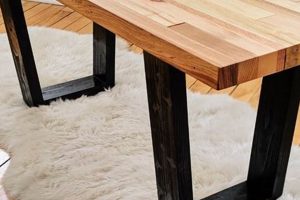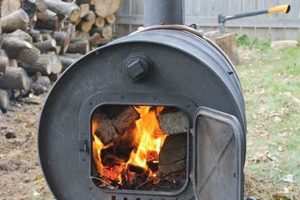Simple, self-constructed shelving units made from wood present a readily accessible organizational solution. These units offer a customizable storage option suitable for various spaces and purposes. A basic example includes constructing a shelf from pre-cut lumber and brackets, requiring minimal tools and expertise.
The appeal of constructing personalized shelving lies in its economic advantages and adaptability. Creating storage solutions independently reduces reliance on commercially manufactured products. Historically, self-sufficiency in home improvement tasks, including furniture creation, has been a common practice driven by necessity and resourcefulness. This approach allows for tailored dimensions, finishes, and configurations, aligning perfectly with individual requirements and aesthetic preferences.
The subsequent sections will explore essential aspects of creating these units, encompassing material selection, design considerations, construction techniques, and finishing options. These topics provide a comprehensive understanding of the process, enabling the reader to successfully implement their own shelving projects.
Constructing Efficient Shelving
The following guidelines aim to optimize the creation and installation of self-assembled wooden shelving units, focusing on durability, aesthetics, and structural integrity.
Tip 1: Prioritize Accurate Measurements: Precise measurements are fundamental to a successful outcome. Double-check all dimensions before cutting lumber or installing hardware. Inaccurate measurements can lead to instability or misalignment, compromising the shelf’s functionality.
Tip 2: Select Appropriate Wood: The choice of wood affects both appearance and load-bearing capacity. Softwoods, such as pine, are cost-effective but may require additional support for heavier items. Hardwoods, such as oak or maple, offer greater strength and resistance to wear.
Tip 3: Ensure Proper Support: Brackets should be adequately sized and spaced to distribute weight evenly. Consider the weight capacity of each bracket and the anticipated load on the shelf. Insufficient support can result in sagging or collapse.
Tip 4: Employ Secure Fasteners: Use screws of appropriate length and gauge to securely attach shelving boards to brackets or support structures. Pilot holes are recommended to prevent wood splitting, particularly with hardwoods. Consider using wood glue for added strength.
Tip 5: Apply a Protective Finish: Sealing or staining the wood protects it from moisture, scratches, and UV damage. A clear coat or stain can enhance the wood’s natural grain and provide a durable, easy-to-clean surface.
Tip 6: Maintain Level Installation: Use a level during installation to ensure shelves are perfectly horizontal. Uneven shelves can cause items to slide or topple. Shims may be necessary to correct minor imperfections in wall surfaces.
Tip 7: Pre-Drill Screw Holes: Drilling pilot holes smaller than the screw diameter is essential to prevent splitting the wood when inserting screws. This is especially important when working near the edges of boards.
Adhering to these principles contributes significantly to the construction of stable, aesthetically pleasing, and enduring shelving solutions.
The next section summarizes essential information presented and provides concluding remarks.
1. Material Selection
The success of self-constructed shelving is directly contingent upon judicious material selection. The inherent properties of chosen wood dictate the shelf’s load-bearing capacity, resistance to environmental factors, and overall lifespan. Opting for a softwood like pine offers cost savings but necessitates careful consideration of load limits. Conversely, hardwoods such as oak or maple provide superior strength and durability, suitable for supporting heavier items. Inadequate material selection can lead to structural failure, rendering the shelving unit unsafe and unusable. For example, a pine shelf supporting a collection of books may exhibit sagging over time, whereas an oak shelf would maintain its form under the same load.
Beyond structural considerations, the chosen wood also influences the aesthetic appeal of the shelving. Different wood species exhibit varying grain patterns and natural colors. Pine often presents a knotty, rustic appearance, while maple offers a smoother, more uniform surface. The selected finish further accentuates these characteristics. Staining or painting can alter the wood’s color and protect it from moisture and scratches, influencing its long-term appearance. Proper material selection, therefore, involves considering both the functional requirements and the desired aesthetic outcome.
In summary, material selection represents a foundational element in the creation of robust and visually appealing shelving units. Understanding the properties of different wood species and their suitability for specific applications is paramount. Challenges such as budget constraints versus performance requirements must be carefully weighed to achieve a balance between cost-effectiveness and structural integrity, ultimately contributing to the overall success of the project. The selection process links directly to the overall goals of creating functional and aesthetically-pleasing shelving using a do-it-yourself approach.
2. Accurate Measurement
Accurate measurement forms the bedrock upon which successful self-assembled shelving projects are built. Deviations from precise dimensions compromise structural integrity and aesthetic appeal, ultimately negating the intended benefits of a do-it-yourself approach.
- Shelf Alignment and Stability
Miscalculations in length, width, or height directly impact shelf alignment. Even slight discrepancies can lead to unstable structures prone to wobbling or collapse, particularly when loaded with weight. For instance, if shelf supports are not precisely the same height, the shelf itself will tilt, making it unsuitable for holding items securely.
- Component Fit and Assembly
Precise measurements are critical for proper component fit. Shelves that are too long or too short will not fit correctly between supports. Similarly, improperly measured bracket placement results in uneven weight distribution, potentially weakening the structure. Imagine attempting to install a shelf into a recess where the shelf is even a quarter inch too wide; installation becomes significantly more difficult, if not impossible, without modification.
- Material Optimization and Waste Reduction
Accurate measurements minimize material waste by ensuring efficient cuts from lumber. Imprecise measurements lead to unusable scraps and increased material costs. For example, calculating the exact lumber needed for several shelves beforehand allows for optimized cuts from standard lumber lengths, thereby reducing waste and overall project expenses.
- Aesthetic Consistency and Visual Harmony
Precise dimensions contribute to a visually harmonious finished product. Consistent shelf spacing and uniform component sizes create a polished, professional appearance. Deviations are readily apparent and detract from the overall aesthetic. Envision a shelving unit with shelves of noticeably different depths; the visual inconsistency disrupts the overall impression.
In conclusion, accurate measurement is not merely a preliminary step but an integral component of the entire shelving construction process. Adherence to precise dimensions directly correlates with the stability, functionality, and aesthetic appeal of the completed shelving unit, underscoring its crucial role in realizing a successful and satisfying do-it-yourself project.
3. Secure Fastening
Secure fastening represents a critical determinant of structural integrity in self-assembled wooden shelving. The method and quality of joining components directly influence the unit’s ability to withstand load and resist deformation over time.
- Screw Selection and Application
The selection of appropriate screw types is paramount. Screw length should adequately penetrate both joining members, ensuring a firm grip without protruding excessively. Pilot holes, drilled slightly smaller than the screw’s thread diameter, prevent wood splitting, especially in hardwoods. The use of coarse-threaded screws provides superior holding power in softer woods. For example, using drywall screws in place of wood screws can lead to premature failure due to their brittle nature and tendency to snap under shear stress. Correct screw selection and pilot hole drilling contribute significantly to joint strength.
- Adhesive Bonding Enhancement
Combining mechanical fasteners with adhesive bonding provides a synergistic increase in joint strength. Wood glue, applied to mating surfaces before assembly, creates a continuous bond that distributes stress more evenly. This reduces reliance on individual fasteners and minimizes the risk of localized failure. For instance, gluing shelf supports to the shelf boards, in addition to screwing them together, dramatically enhances the overall rigidity and load-bearing capacity of the shelf unit.
- Bracket and Support Attachment
The method of attaching brackets and support structures to both the shelf and the supporting wall is crucial. Brackets should be securely fastened to wall studs whenever possible, using screws of sufficient length and gauge to penetrate deeply into the stud. For non-stud installations, appropriate wall anchors must be used to distribute the load and prevent pull-out. An example of inadequate bracket attachment would be using short screws to attach a bracket to drywall without anchors, resulting in the bracket pulling away from the wall under even moderate load.
- Joint Reinforcement Techniques
Employing joint reinforcement techniques, such as dowels or biscuits, adds significant strength to mitered or butt joints. These techniques provide increased surface area for adhesive bonding and create mechanical interlocking between the joined members. A shelf constructed with simple butt joints relies solely on the fasteners and adhesive for strength; the addition of dowels or biscuits dramatically increases the joint’s resistance to shear and tensile forces, resulting in a more robust and durable shelving unit.
The integrity of self-assembled shelving hinges on the proper application of secure fastening principles. Careful consideration of screw selection, adhesive bonding, bracket attachment, and joint reinforcement contributes directly to a structurally sound and enduring storage solution. The absence of secure fastening jeopardizes the stability and longevity of the entire structure.
4. Stable Support
Stable support is a non-negotiable element for “easy diy wooden shelves”. A lack of adequate support negates the intended function of these shelves, rendering them structurally unsound and potentially hazardous. The connection is causal: insufficient support leads to shelf sagging, collapse, and potential damage to stored items, thereby defeating the purpose of creating an accessible and functional storage solution. The implementation of secure and appropriate support systems is therefore not merely an aesthetic consideration but a fundamental requirement for the utility and safety of any shelving project.
The importance of stable support is further exemplified through various real-world scenarios. Consider a scenario where shelves are constructed using lightweight brackets spaced too far apart. The result is a pronounced sag in the shelf’s center when loaded with even moderately heavy items, such as books or kitchenware. This sagging not only looks visually unappealing but also compromises the shelf’s structural integrity. Conversely, shelves utilizing sturdy brackets installed at shorter intervals, or shelves incorporating vertical supports along their span, maintain their level and stable form, effectively bearing the intended load without deformation. Moreover, the type of wall to which the shelves are anchored plays a crucial role. Shelves attached to solid wood studs offer significantly greater stability compared to those attached solely to drywall, which requires specialized anchors to distribute the weight effectively. The absence of appropriate wall anchors can lead to the screws pulling out of the drywall, resulting in shelf failure.
In summation, ensuring stable support for “easy diy wooden shelves” is paramount. It involves careful consideration of bracket selection, spacing, and anchoring methods, as well as an understanding of the intended load and the structural characteristics of the supporting wall. Challenges such as limited space, budget constraints, or the need to adapt to existing architectural features can be addressed through creative design solutions, such as incorporating additional support elements or utilizing materials with higher strength-to-weight ratios. Ultimately, the success of an “easy diy wooden shelves” project hinges on prioritizing stable support as a fundamental design principle.
5. Protective Finish
The application of a protective finish to self-constructed wooden shelving is not merely an aesthetic choice but a critical step in ensuring longevity and functionality. The absence of a protective layer renders the wood susceptible to environmental factors, physical damage, and biological degradation. The direct causal link exists: unprotected wood absorbs moisture, warps, cracks, and becomes vulnerable to mold and insect infestation, ultimately shortening the shelf’s lifespan and compromising its structural integrity. This process directly counteracts the intended purpose of creating durable and cost-effective storage solutions. The selection of a suitable finish, therefore, is integral to realizing the benefits of undertaking such a project.
The practical significance of understanding the role of a protective finish becomes apparent when considering various use cases. Shelving in a bathroom or kitchen, for example, is exposed to high humidity levels and potential spills. Unfinished wood in these environments would rapidly deteriorate, necessitating frequent repairs or replacements. Similarly, shelving in direct sunlight without UV protection would fade and discolor over time. Applying a sealant, varnish, or paint creates a barrier against these elements, preserving the wood’s appearance and structural integrity. The choice of finish should be tailored to the specific environment and intended use. Water-based finishes offer low VOC emissions and ease of cleanup, while oil-based finishes provide greater durability and water resistance. Furthermore, stain-resistant coatings are essential for shelving intended to hold items that may leak or spill. Regular maintenance of the finish, such as reapplication every few years, is necessary to maintain its protective properties. The type of finish also affects the ease of cleaning the shelves; a smooth, sealed surface is easier to wipe down than raw wood.
In conclusion, the decision to apply a protective finish to self-assembled wooden shelving represents a pivotal investment in the project’s long-term viability. It mitigates the detrimental effects of moisture, UV radiation, and physical wear, thereby maximizing the lifespan and functionality of the shelving unit. Challenges in selecting the appropriate finish can be addressed through research and consultation with experienced professionals. Prioritizing the application and maintenance of a protective finish represents a commitment to the enduring value of DIY projects.
Frequently Asked Questions
This section addresses common inquiries concerning the planning, construction, and maintenance of straightforward wooden shelving units.
Question 1: What wood types are suitable for basic shelving construction?
Both softwoods and hardwoods are viable options. Pine offers economy and ease of workability but may require reinforcement for heavier loads. Oak and maple provide superior strength and durability, suitable for demanding applications.
Question 2: How does one determine appropriate shelf spacing?
Shelf spacing depends on the intended contents. Measure the height of the tallest anticipated item and add clearance. Adjustable shelving systems offer flexibility for varying storage needs.
Question 3: What is the recommended method for securing shelves to a wall?
Fastening to wall studs provides the most secure attachment. In the absence of studs, appropriate wall anchors are necessary to distribute weight and prevent pull-out from drywall or plaster.
Question 4: How can shelf sagging be prevented?
Shelf sagging is mitigated through the use of thicker shelving material, shorter shelf spans, and adequately spaced support brackets. Reinforcement methods, such as adding a center support or using a metal support strip, can also be employed.
Question 5: What finishes are recommended for wooden shelving?
The choice of finish depends on the environment and desired aesthetic. Sealants protect against moisture, while stains enhance the wood’s natural grain. Varnish and paint offer durability and customizable color options.
Question 6: How does one maintain basic wooden shelving?
Regular dusting and cleaning with a damp cloth are essential. Avoid harsh chemicals or abrasive cleaners that could damage the finish. Periodically inspect for signs of damage, such as cracks or loose fasteners, and address them promptly.
In summary, attention to material selection, installation techniques, and ongoing maintenance ensures the longevity and functionality of basic wooden shelving.
The subsequent section presents a concise summary of the key topics covered, offering concluding insights on the construction of straightforward wooden shelving systems.
Concluding Remarks on Simplified Shelving Systems
This exploration of easy diy wooden shelves has emphasized the crucial aspects of design, material selection, construction, and finishing. The structural integrity and longevity of these systems depend on accurate measurements, secure fastening, and stable support. Protective finishes guard against environmental factors and physical wear, ensuring the long-term utility of the shelving unit.
The creation of accessible and functional storage solutions through self-assembly requires a commitment to precision and attention to detail. Properly executed, easy diy wooden shelves represent a cost-effective and customizable alternative to commercially manufactured options, providing durable and aesthetically pleasing organizational solutions. These systems, when thoughtfully planned and meticulously constructed, contribute meaningfully to efficient space management and enhanced domestic environments.


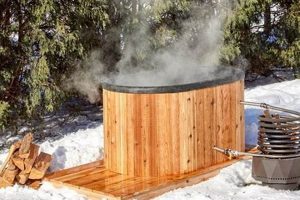
![[DIY Guide] Easy DIY Wood Window Shutters You Can Build! The DIY Hub: Creative Crafts, Repairs & Life Hacks [DIY Guide] Easy DIY Wood Window Shutters You Can Build! | The DIY Hub: Creative Crafts, Repairs & Life Hacks](https://craftingdiycenter.com/wp-content/uploads/2025/07/th-3579-300x200.jpg)
